Comparison of Urban Canopy Schemes and Surface Layer Schemes in the Simulation of a Heatwave in the Xiongan New Area
Abstract
:1. Introduction
2. Model Description and Experimental Design
2.1. WRF Model Description
2.2. Description of Study Areas
2.3. Description of Study Data
2.4. Statistical Metrics
3. Results
3.1. 2-m Temperature
3.2. 2-m Relative Humidity
3.3. 10-m Wind Speed and Direction
4. Discussion
5. Conclusions
Author Contributions
Funding
Institutional Review Board Statement
Informed Consent Statement
Data Availability Statement
Acknowledgments
Conflicts of Interest
References
- Alexander, L.V.; Zhang, X.; Peterson, T.C.; Caesar, J.; Gleason, B.; Klein Tank, A.M.G.; Haylock, M.; Collins, D.; Trewin, B.; Rahimzadeh, F.; et al. Global Observed Changes in Daily Climate Extremes of Temperature and Precipitation. J. Geophys. Res. Atmos. 2006, 111, 1042–1063. [Google Scholar] [CrossRef]
- Bai, X.; Dawson, R.J.; Ürge-Vorsatz, D.; Delgado, G.C.; Salisu Barau, A.; Dhakal, S.; Dodman, D.; Leonardsen, L.; Masson-Delmotte, V.; Roberts, D.C.; et al. Six Research Priorities for Cities and Climate Change. Nature 2018, 555, 23–25. [Google Scholar] [CrossRef] [PubMed]
- Highlights of the IPCC Working Group I Fifth Assessment Report. Available online: http://www.climatechange.cn/EN/lexeme/showArticleByLexeme.do?articleID=606 (accessed on 15 August 2022).
- Perkins, S.E.; Alexander, L.V.; Nairn, J.R. Increasing Frequency, Intensity and Duration of Observed Global Heatwaves and Warm Spells. Geophys. Res. Lett. 2012, 39, L20714. [Google Scholar] [CrossRef]
- Ebi, K.L.; Capon, A.; Berry, P.; Broderick, C.; de Dear, R.; Havenith, G.; Honda, Y.; Kovats, R.S.; Ma, W.; Malik, A.; et al. Hot Weather and Heat Extremes: Health Risks. Lancet 2021, 398, 698–708. [Google Scholar] [CrossRef]
- Hass, A.L.; Ellis, K.N. Motivation for Heat Adaption: How Perception and Exposure Affect Individual Behaviors During Hot Weather in Knoxville, Tennessee. Atmosphere 2019, 10, 591. [Google Scholar] [CrossRef]
- Wu, Y.; Wang, X.; Wu, J.; Wang, R.; Yang, S. Performance of Heat-Health Warning Systems in Shanghai Evaluated by Using Local Heat-Related Illness Data. Sci. Total Environ. 2020, 715, 136883. [Google Scholar] [CrossRef]
- Gu, S.; Huang, C.; Bai, L.; Chu, C.; Liu, Q. Heat-Related Illness in China, Summer of 2013. Int. J. Biometeorol. 2016, 60, 131–137. [Google Scholar] [CrossRef]
- Bai, L.; Ding, G.; Gu, S.; Bi, P.; Su, B.; Qin, D.; Xu, G.; Liu, Q. The Effects of Summer Temperature and Heat Waves on Heat-Related Illness in a Coastal City of China, 2011–2013. Environ. Res. 2014, 132, 212–219. [Google Scholar] [CrossRef]
- Guo, X.; Huang, J.; Luo, Y.; Zhao, Z.; Xu, Y. Projection of Heat Waves over China for Eight Different Global Warming Targets Using 12 CMIP5 Models. Theor. Appl. Climatol. 2017, 128, 507–522. [Google Scholar] [CrossRef]
- Kang, S.; Eltahir, E.A.B. North China Plain Threatened by Deadly Heatwaves Due to Climate Change and Irrigation. Nat. Commun. 2018, 9, 2894. [Google Scholar] [CrossRef] [Green Version]
- Qian, C.; Cao, L.-J. Linear Trends in Mean and Extreme Temperature in Xiongan New Area, China. Atmos. Ocean. Sci. Lett. 2018, 11, 246–254. [Google Scholar] [CrossRef]
- Huang, D.; Liao, Y.; Han, Z. Projection of Key Meteorological Hazard Factors in Xiongan New Area of Hebei Province, China. Sci. Rep. 2021, 11, 18675. [Google Scholar] [CrossRef] [PubMed]
- Wang, Y.; Song, L.; Han, Z.; Liao, Y.; Xu, H.; Zhai, J.; Zhu, R. Climate-Related Risks in the Construction of Xiongan New Area, China. Theor. Appl. Climatol. 2020, 141, 1301–1311. [Google Scholar] [CrossRef]
- Dupont, S.; Otte, T.L.; Ching, J.K.S. Simulation of Meteorological Fields Within and Above Urban and Rural Canopies with a Mesoscale Model. Bound.-Layer Meteorol. 2004, 113, 111–158. [Google Scholar] [CrossRef]
- Grossman-Clarke, S.; Zehnder, J.A.; Loridan, T.; Grimmond, C.S.B. Contribution of Land Use Changes to Near-Surface Air Temperatures during Recent Summer Extreme Heat Events in the Phoenix Metropolitan Area. J. Appl. Meteorol. Climatol. 2010, 49, 1649–1664. [Google Scholar] [CrossRef]
- Salamanca, F.; Krpo, A.; Martilli, A.; Clappier, A. A New Building Energy Model Coupled with an Urban Canopy Parameterization for Urban Climate Simulations—Part I. Formulation, Verification, and Sensitivity Analysis of the Model. Theor. Appl. Climatol. 2010, 99, 331–344. [Google Scholar] [CrossRef]
- Chen, F.; Kusaka, H.; Bornstein, R.; Ching, J.; Grimmond, C.S.B.; Grossman-Clarke, S.; Loridan, T.; Manning, K.W.; Martilli, A.; Miao, S.; et al. The Integrated WRF/Urban Modelling System: Development, Evaluation, and Applications to Urban Environmental Problems. Int. J. Clim. 2011, 31, 273–288. [Google Scholar] [CrossRef]
- Li, D.; Bou-Zeid, E. Synergistic Interactions between Urban Heat Islands and Heat Waves: The Impact in Cities Is Larger than the Sum of Its Parts. J. Appl. Meteorol. Climatol. 2013, 52, 2051–2064. [Google Scholar] [CrossRef]
- Chen, L.; Frauenfeld, O.W. Impacts of Urbanization on Future Climate in China. Clim. Dyn. 2016, 47, 345–357. [Google Scholar] [CrossRef]
- Loughner, C.P.; Allen, D.J.; Zhang, D.-L.; Pickering, K.E.; Dickerson, R.R.; Landry, L. Roles of Urban Tree Canopy and Buildings in Urban Heat Island Effects: Parameterization and Preliminary Results. J. Appl. Meteorol. Climatol. 2012, 51, 1775–1793. [Google Scholar] [CrossRef]
- de la Paz, D.; Borge, R.; Martilli, A. Assessment of a High Resolution Annual WRF-BEP/CMAQ Simulation for the Urban Area of Madrid (Spain). Atmos. Environ. 2016, 144, 282–296. [Google Scholar] [CrossRef]
- Pappaccogli, G.; Giovannini, L.; Zardi, D.; Martilli, A. Assessing the Ability of WRF-BEP + BEM in Reproducing the Wintertime Building Energy Consumption of an Italian Alpine City. J. Geophys. Res. Atmos. 2021, 126, e2020JD033652. [Google Scholar] [CrossRef]
- Stull, R.B. An Introduction to Boundary Layer Meteorology; Springer: Berlin/Heidelberg, Germany, 1988. [Google Scholar]
- Shin, H.H.; Hong, S.-Y. Intercomparison of Planetary Boundary-Layer Parametrizations in the WRF Model for a Single Day from CASES-99. Bound.-Layer Meteorol. 2011, 139, 261–281. [Google Scholar] [CrossRef]
- Draxl, C.; Hahmann, A.N.; Peña, A.; Giebel, G. Evaluating Winds and Vertical Wind Shear from Weather Research and Forecasting Model Forecasts Using Seven Planetary Boundary Layer Schemes: Evaluation of Wind Shear in the WRF Model. Wind Energy 2014, 17, 39–55. [Google Scholar] [CrossRef]
- Hu, X.-M.; Nielsen-Gammon, J.W.; Zhang, F. Evaluation of Three Planetary Boundary Layer Schemes in the WRF Model. J. Appl. Meteorol. Climatol. 2010, 49, 1831–1844. [Google Scholar] [CrossRef]
- Ban, J.; Gao, Z.; Lenschow, D.H. Climate Simulations with a New Air-Sea Turbulent Flux Parameterization in the National Center for Atmospheric Research Community Atmosphere Model (CAM3). J. Geophys. Res. 2010, 115, D01106. [Google Scholar] [CrossRef]
- Best, M.J.; Pryor, M.; Clark, D.B.; Rooney, G.G.; Essery, R.L.H.; Ménard, C.B.; Edwards, J.M.; Hendry, M.A.; Porson, A.; Gedney, N.; et al. The Joint UK Land Environment Simulator (JULES), Model Description—Part 1: Energy and Water Fluxes. Geosci. Model Dev. 2011, 4, 677–699. [Google Scholar] [CrossRef]
- Kiehl, J.T.; Briegleb, B.P. The Relative Roles of Sulfate Aerosols and Greenhouse Gases in Climate Forcing. Science 1993, 260, 311–314. [Google Scholar] [CrossRef]
- Gao, Z.; Bian, L.; Zhou, X. Measurements of Turbulent Transfer in the Near-Surface Layer over a Rice Paddy in China: Measurements of Fluxes Over Rice Paddy. J. Geophys. Res. 2003, 108, 4387. [Google Scholar] [CrossRef]
- Hari Prasad, K.B.R.R.; Venkata Srinivas, C.; Venkateswara Naidu, C.; Baskaran, R.; Venkatraman, B. Assessment of Surface Layer Parameterizations in ARW Using Micro-Meteorological Observations from a Tropical Station. Meteorol. Appl. 2016, 23, 191–208. [Google Scholar] [CrossRef] [Green Version]
- Peng, Y.; Wang, H.; Li, Y.; Liu, C.; Zhao, T.; Zhang, X.; Gao, Z.; Jiang, T.; Che, H.; Zhang, M. Evaluating the Performance of Two Surface Layer Schemes for the Momentum and Heat Exchange Processes during Severe Haze Pollution in Jing-Jin-Ji in Eastern China. Atmos. Chem. Phys. 2018, 18, 17421–17435. [Google Scholar] [CrossRef]
- Skamarock, C.; Klemp, B.; Dudhia, J.; Gill, O.; Liu, Z.; Berner, J.; Wang, W.; Powers, G.; Duda, G.; Barker, D.; et al. A Description of the Advanced Research WRF Model Version 4.3; National Center for Atmospheric Research: Boulder, CO, USA, 2021. [Google Scholar] [CrossRef]
- Hong, S.-Y.; Dudhia, J.; Chen, S.-H. A Revised Approach to Ice Microphysical Processes for the Bulk Parameterization of Clouds and Precipitation. Mon. Wea. Rev. 2004, 132, 103–120. [Google Scholar] [CrossRef]
- Mlawer, E.J.; Taubman, S.J.; Brown, P.D.; Iacono, M.J.; Clough, S.A. Radiative Transfer for Inhomogeneous Atmospheres: RRTM, a Validated Correlated-k Model for the Longwave. J. Geophys. Res. 1997, 102, 16663–16682. [Google Scholar] [CrossRef]
- Dudhia, J. Numerical Study of Convection Observed during the Winter Monsoon Experiment Using a Mesoscale Two-Dimensional Model. J. Atmos. 1989, 46, 3077–3107. [Google Scholar] [CrossRef]
- Chen, F.; Dudhia, J. Coupling an Advanced Land Surface–Hydrology Model with the Penn State–NCAR MM5 Modeling System. Part I: Model Implementation and Sensitivity. Mon. Weather. Rev. 2001, 129, 569–585. [Google Scholar] [CrossRef]
- Monin, A.; Obukhov, S. Basic Laws of Turbulent Mixing in the Surface Layer of the Atmosphere. Contrib. Geophys. Inst. Acad. Sci. USSR 1954, 151, e187. [Google Scholar]
- Janjic, Z.I. The Surface Layer in the NCEP Eta Model. In Proceedings of the 11th Conference on Numerical Weather Prediction, Norfolk, VA, USA, 19–23 August 1996. [Google Scholar]
- Janjić, Z.I. Comments on “Development and Evaluation of a Convection Scheme for Use in Climate Models”. J. Atmos. Sci. 2000, 57, 3686. [Google Scholar] [CrossRef]
- Nonsingular Implementation of the Mellor-Yamada Level 2.5 Scheme in the NCEP Meso Model. Available online: https://repository.library.noaa.gov/view/noaa/11409 (accessed on 15 August 2022).
- Holtslag, A.A.M.; De Bruin, H.A.R. Applied Modeling of the Nighttime Surface Energy Balance over Land. J. Appl. Meteorol. Climatol. 1988, 27, 689–704. [Google Scholar] [CrossRef]
- Paulson, C.A. The Mathematical Representation of Wind Speed and Temperature Profiles in the Unstable Atmospheric Surface Layer. J. Appl. Meteorol. Climatol. 1970, 9, 857–861. [Google Scholar] [CrossRef]
- Raei, E.; Nikoo, M.R.; AghaKouchak, A.; Mazdiyasni, O.; Sadegh, M. GHWR, a Multi-Method Global Heatwave and Warm-Spell Record and Toolbox. Sci. Data 2018, 5, 180206. [Google Scholar] [CrossRef] [Green Version]
- Taylor, K.E. Summarizing Multiple Aspects of Model Performance in a Single Diagram. J. Geophys. Res. 2001, 106, 7183–7192. [Google Scholar] [CrossRef]
- Moazenzadeh, R.; Mohammadi, B.; Shamshirband, S.; Chau, K. Coupling a Firefly Algorithm with Support Vector Regression to Predict Evaporation in Northern Iran. Eng. Appl. Comput. Fluid Mech. 2018, 12, 584–597. [Google Scholar] [CrossRef]
- Wadoux, A.M.J.-C.; Walvoort, D.J.J.; Brus, D.J. An Integrated Approach for the Evaluation of Quantitative Soil Maps through Taylor and Solar Diagrams. Geoderma 2022, 405, 115332. [Google Scholar] [CrossRef]
- Xie, B.; Fung, J.C.H.; Chan, A.; Lau, A. Evaluation of Nonlocal and Local Planetary Boundary Layer Schemes in the WRF Model: Evaluation of pbl schemes in wrf. J. Geophys. Res. 2012, 117, D22S10. [Google Scholar] [CrossRef]
- Yang, T.; Li, H.; Cao, J.; Lu, Q.; Wang, Z.; He, L.; Sun, H.; Han, K. Investigating the Climatology of North China’s Urban Inland Lake Based on Six Years of Observations. Sci. Total Environ. 2022, 826, 154120. [Google Scholar] [CrossRef]
- Ribeiro, I.; Martilli, A.; Falls, M.; Zonato, A.; Villalba, G. Highly Resolved WRF-BEP/BEM Simulations over Barcelona Urban Area with LCZ. Atmos. Res. 2021, 248, 105220. [Google Scholar] [CrossRef]
- Jia, W.; Jiang, H.; Yuan, W.; Chao, L.; Wang, C. The effect of planetary boundary layer parameterization schemes and surface layer schemes in mesoscale weather research forecasting model on the simulation of surface layer meteorological parameters at dongshan, suzhou in winter. Sci. Technol. Eng. 2019, 17, 32–43. [Google Scholar] [CrossRef]
- Huang, M.; Gao, Z.; Miao, S.; Chen, F. Sensitivity of Urban Boundary Layer Simulation to Urban Canopy Models and PBL Schemes in Beijing. Meteorol. Atmos. Phys. 2019, 131, 1235–1248. [Google Scholar] [CrossRef]
- Ďoubalová, J.; Huszár, P.; Eben, K.; Benešová, N.; Belda, M.; Vlček, O.; Karlický, J.; Geletič, J.; Halenka, T. High Resolution Air Quality Forecasting over Prague within the URBI PRAGENSI Project: Model Performance during the Winter Period and the Effect of Urban Parameterization on PM. Atmosphere 2020, 11, 625. [Google Scholar] [CrossRef]
- Kadaverugu, R.; Purohit, V.; Matli, C.; Biniwale, R. Improving Accuracy in Simulation of Urban Wind Flows by Dynamic Downscaling WRF with OpenFOAM. Urban Clim. 2021, 38, 100912. [Google Scholar] [CrossRef]
- He, X.; Li, Y.; Wang, X.; Chen, L.; Yu, B.; Zhang, Y.; Miao, S. High-Resolution Dataset of Urban Canopy Parameters for Beijing and Its Application to the Integrated WRF/Urban Modelling System. J. Clean. Prod. 2019, 208, 373–383. [Google Scholar] [CrossRef]
- Keeler, J.M.; Kristovich, D.A.R. Observations of Urban Heat Island Influence on Lake-Breeze Frontal Movement. J. Appl. Meteorol. Climatol. 2012, 51, 702–710. [Google Scholar] [CrossRef]
- Sharma, A.; Fernando, H.J.; Hamlet, A.F.; Hellmann, J.; Barlage, M.J.; Chen, F. Sensitivity of WRF Model to Landuse, with Applications to Chicago Metropolitan Urban Heat Island and Lake Breeze. AGU Fall Meet. Abstr. 2015, 2015, A32G-06. [Google Scholar]


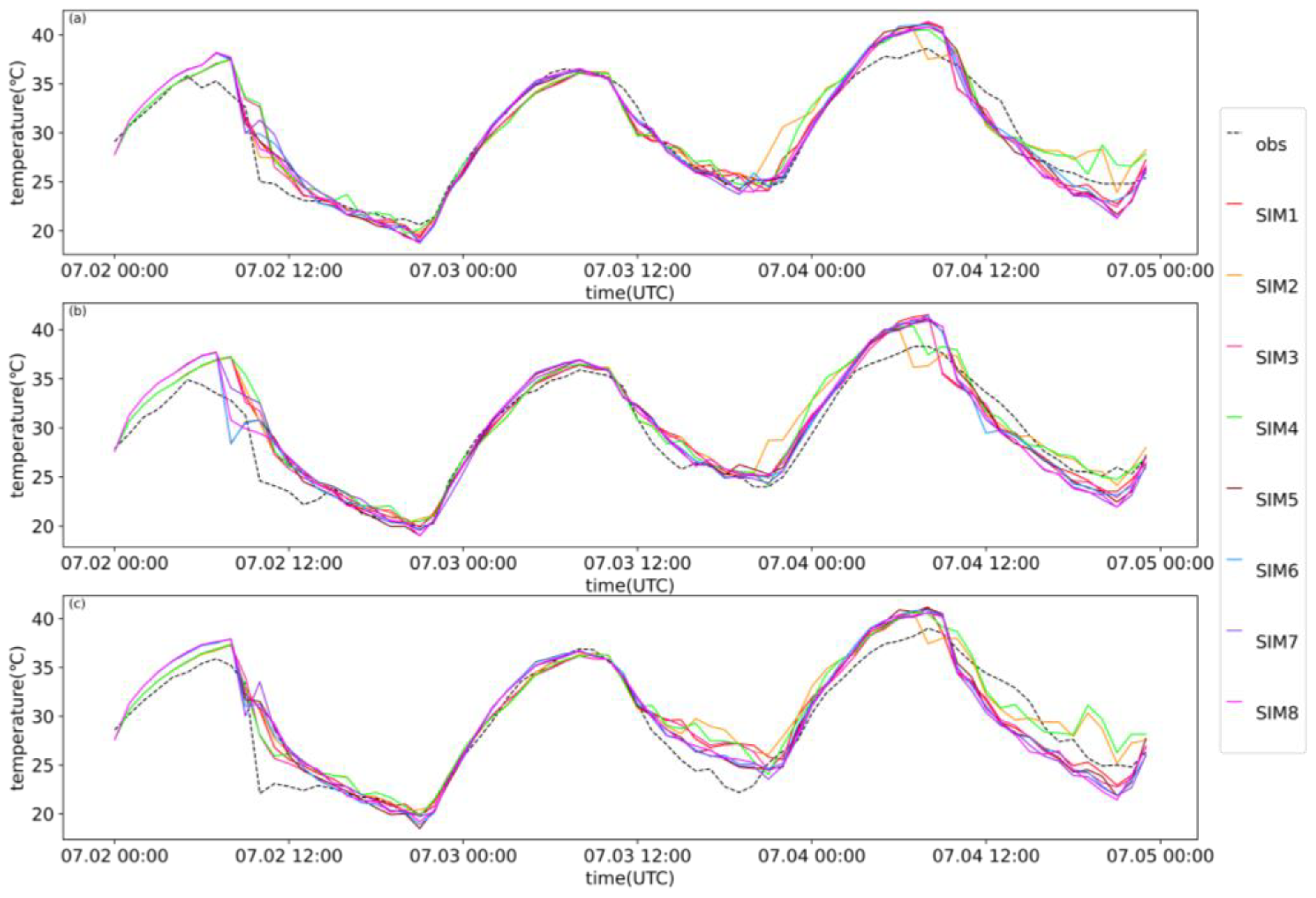
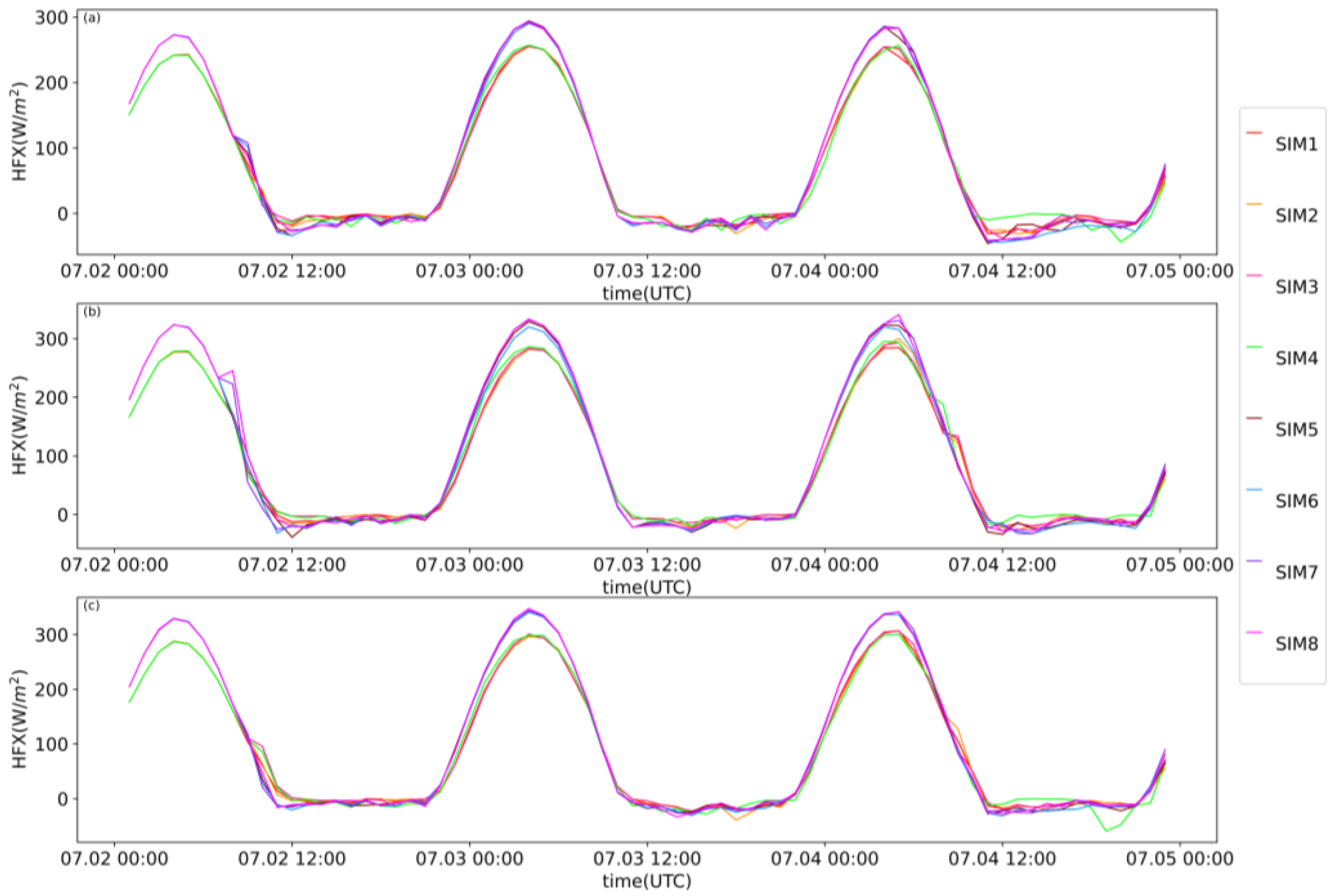
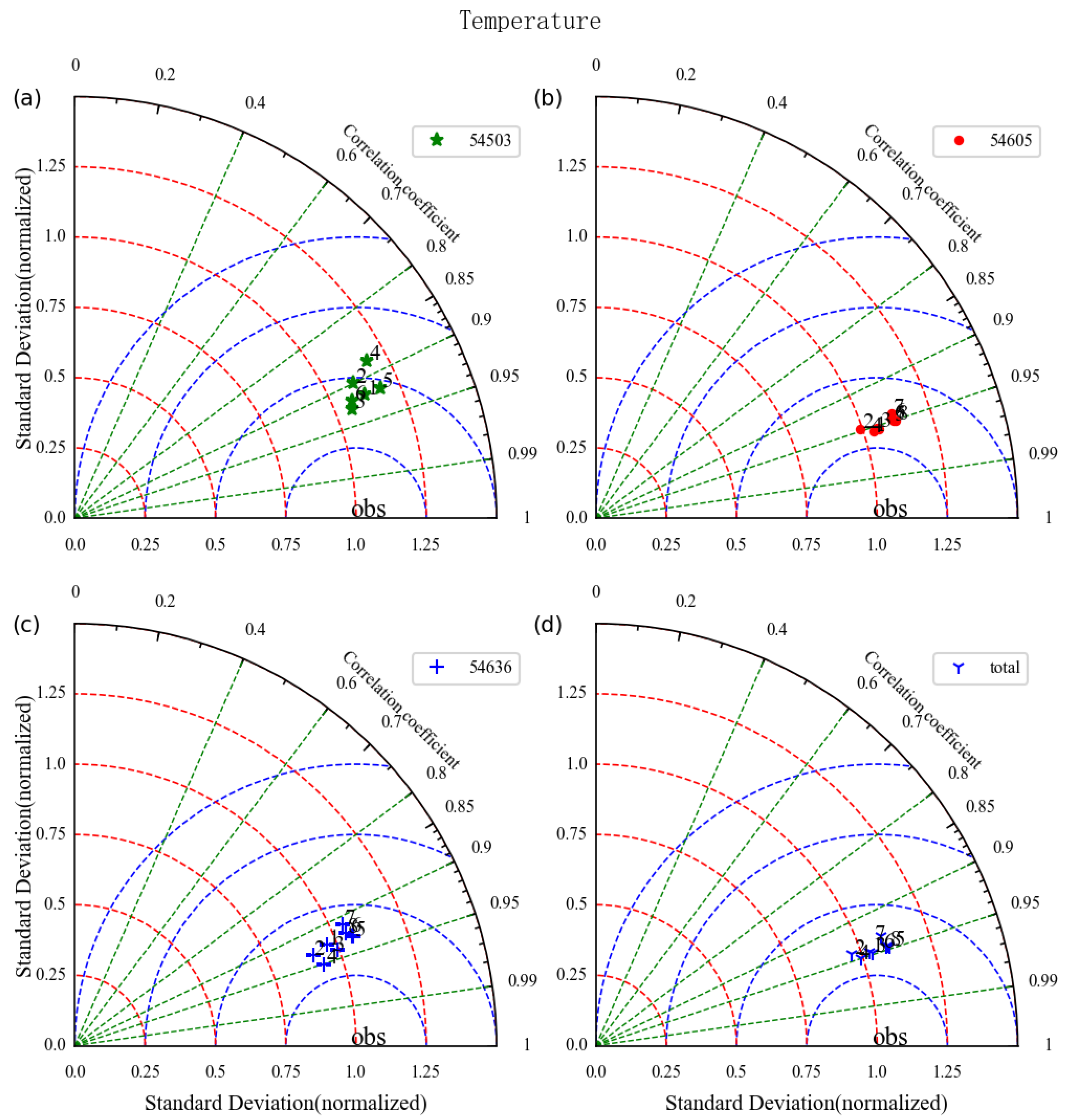
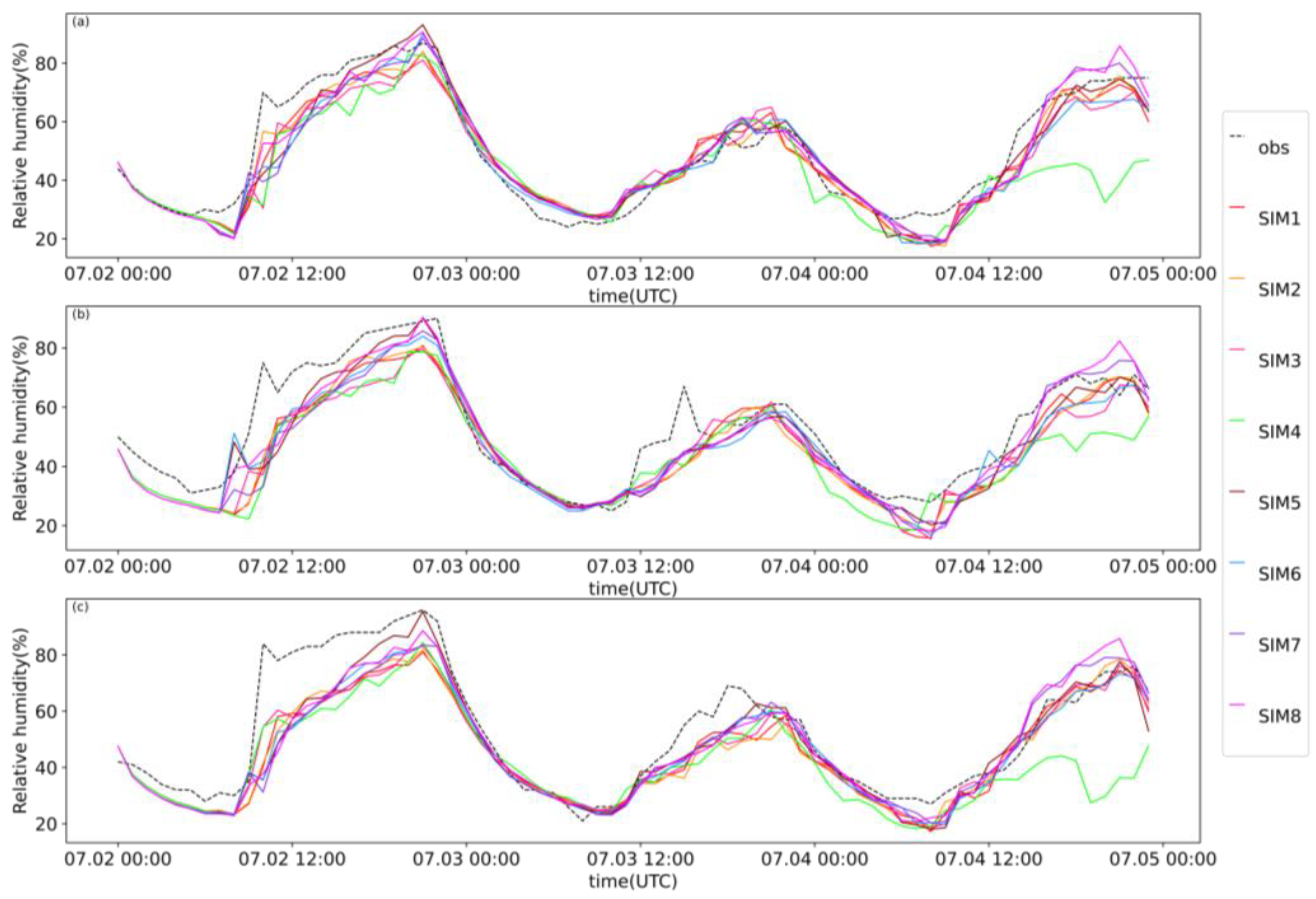
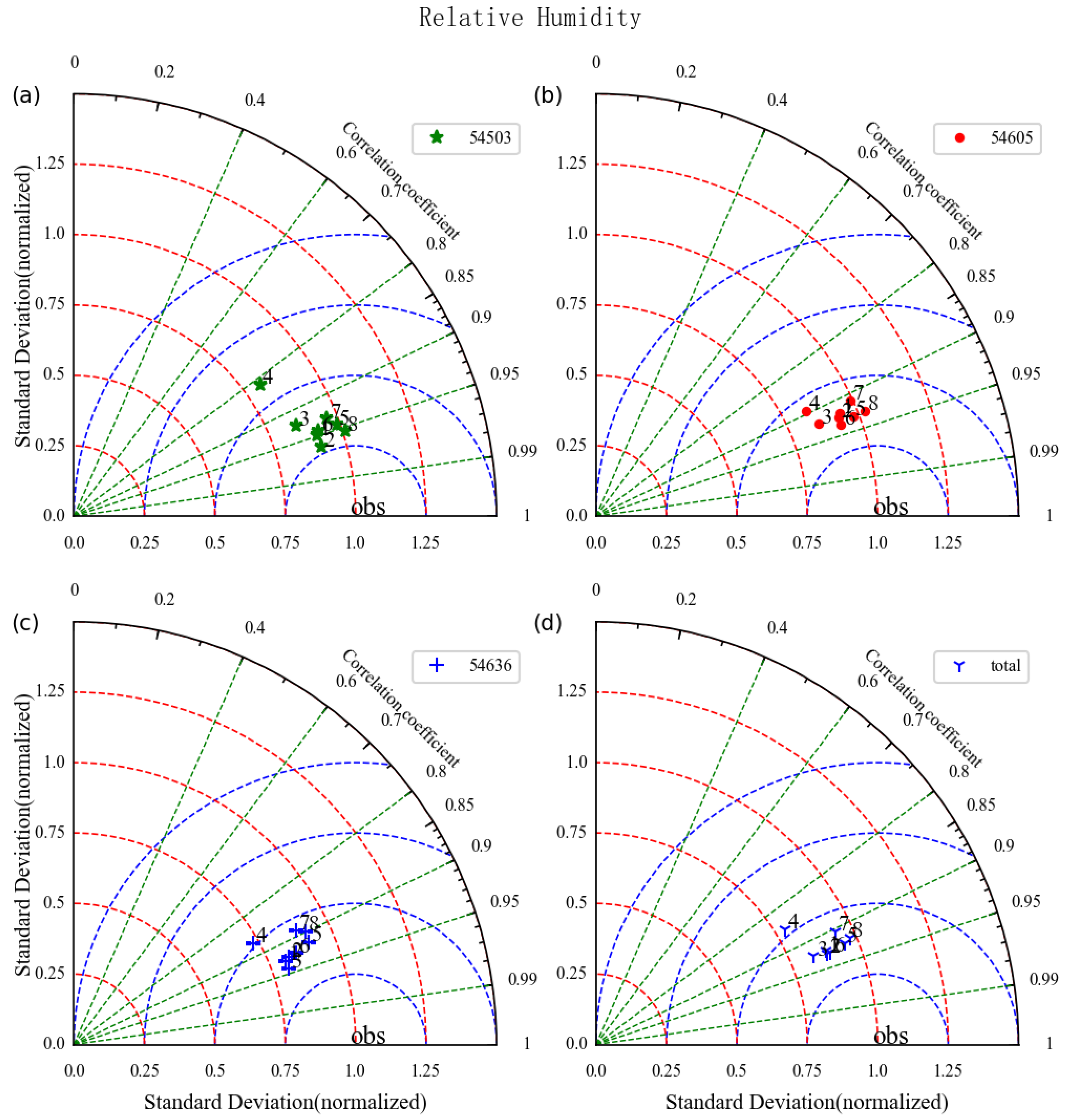
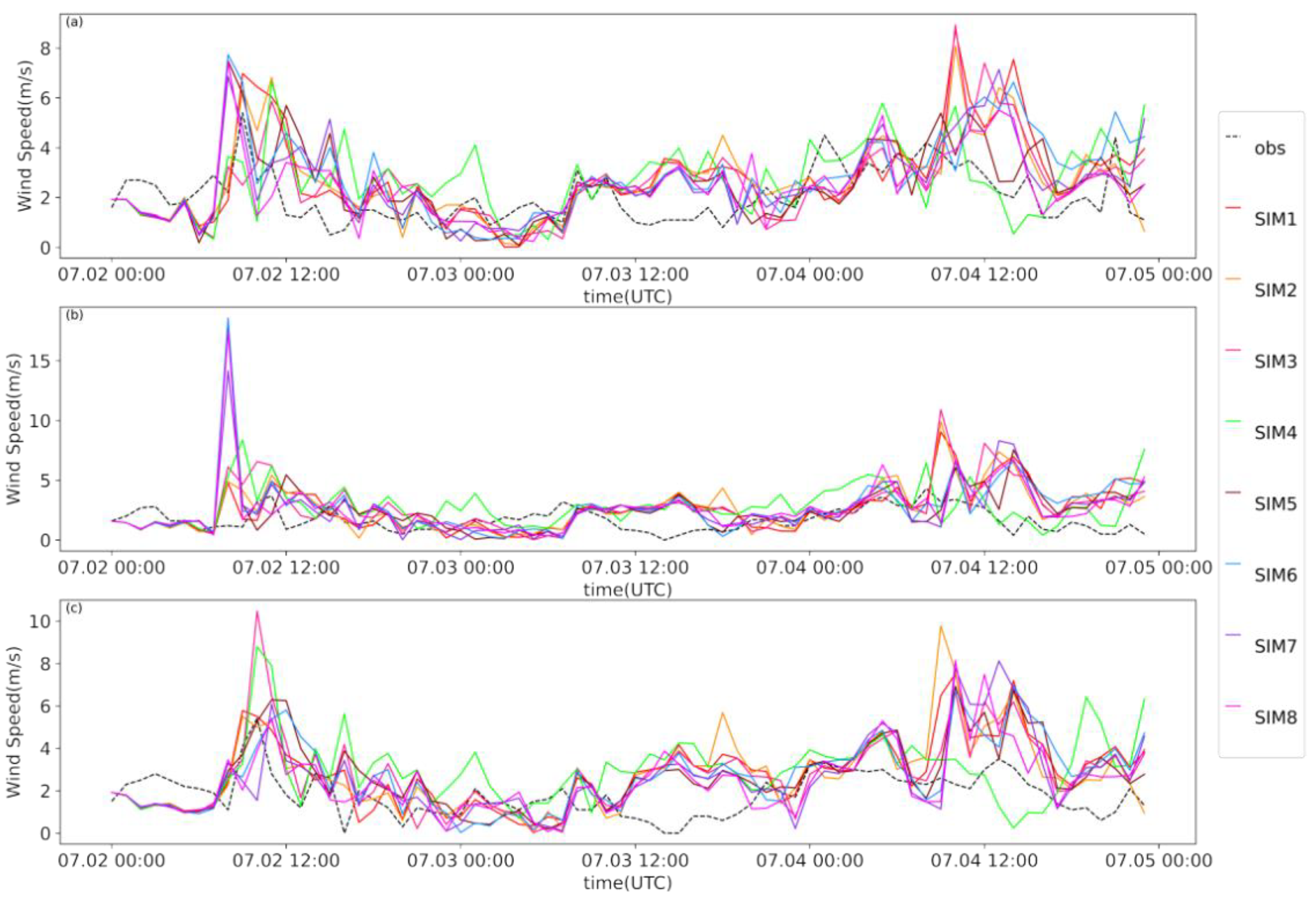

| Scheme | SIM1 | SIM2 | SIM3 | SIM4 | SIM5 | SIM6 | SIM7 | SIM8 |
|---|---|---|---|---|---|---|---|---|
| urban canopy | SLAB | UCM | BEP | BEP + BEM | SLAB | UCM | BEP | BEP + BEM |
| surface layer | MM5 | MM5 | MM5 | MM5 | Eta | Eta | Eta | Eta |
| Station | Measure | SIM1 | SIM2 | SIM3 | SIM4 | SIM5 | SIM6 | SIM7 | SIM8 |
|---|---|---|---|---|---|---|---|---|---|
| 54,503 | IOA | 0.98 | 0.97 | 0.98 | 0.97 | 0.98 | 0.98 | 0.97 | 0.98 |
| MB/°C | −0.01 | 0.45 | −0.01 | 0.58 | 0.02 | 0.17 | 0.00 | 0.03 | |
| R | 0.96 | 0.95 | 0.96 | 0.95 | 0.97 | 0.97 | 0.95 | 0.97 | |
| STDE | 1.07 | 1.00 | 1.08 | 1.02 | 1.13 | 1.11 | 1.11 | 1.13 | |
| RMSE | 0.28 | 0.31 | 0.31 | 0.32 | 0.30 | 0.30 | 0.34 | 0.29 | |
| 54,605 | IOA | 0.97 | 0.96 | 0.97 | 0.97 | 0.97 | 0.97 | 0.96 | 0.97 |
| MB/°C | 0.71 | 0.99 | 0.68 | 1.04 | 0.63 | 0.58 | 0.61 | 0.63 | |
| R | 0.95 | 0.95 | 0.95 | 0.95 | 0.95 | 0.95 | 0.94 | 0.95 | |
| STDE | 1.06 | 0.99 | 1.05 | 1.04 | 1.12 | 1.11 | 1.12 | 1.12 | |
| RMSE | 0.32 | 0.32 | 0.32 | 0.31 | 0.35 | 0.36 | 0.38 | 0.35 | |
| 54,636 | IOA | 0.96 | 0.95 | 0.97 | 0.96 | 0.96 | 0.96 | 0.95 | 0.96 |
| MB/°C | 0.60 | 1.19 | 0.40 | 1.18 | 0.49 | 0.46 | 0.37 | 0.47 | |
| R | 0.93 | 0.93 | 0.94 | 0.95 | 0.93 | 0.93 | 0.91 | 0.92 | |
| STDE | 0.97 | 0.91 | 0.99 | 0.93 | 1.06 | 1.06 | 1.04 | 1.04 | |
| RMSE | 0.37 | 0.36 | 0.35 | 0.31 | 0.39 | 0.39 | 0.43 | 0.40 | |
| total | IOA | 0.97 | 0.96 | 0.97 | 0.97 | 0.97 | 0.97 | 0.96 | 0.97 |
| MB/°C | 0.44 | 0.88 | 0.36 | 0.94 | 0.38 | 0.41 | 0.33 | 0.37 | |
| R | 0.95 | 0.94 | 0.95 | 0.95 | 0.95 | 0.95 | 0.93 | 0.95 | |
| STDE | 1.03 | 0.97 | 1.04 | 0.99 | 1.10 | 1.09 | 1.09 | 1.09 | |
| RMSE | 0.33 | 0.34 | 0.33 | 0.32 | 0.35 | 0.35 | 0.39 | 0.36 |
| Station | Measure | SIM1 | SIM2 | SIM3 | SIM4 | SIM5 | SIM6 | SIM7 | SIM8 |
|---|---|---|---|---|---|---|---|---|---|
| 54,503 | IOA | 0.97 | 0.98 | 0.95 | 0.87 | 0.97 | 0.96 | 0.96 | 0.98 |
| MB/% | −2.16 | −2.10 | −2.64 | −6.35 | −1.46 | −2.81 | −1.30 | −0.74 | |
| R | 0.95 | 0.96 | 0.93 | 0.82 | 0.94 | 0.94 | 0.93 | 0.95 | |
| STDE | 0.91 | 0.91 | 0.85 | 0.81 | 0.99 | 0.92 | 0.96 | 1.01 | |
| RMSE | 0.32 | 0.27 | 0.38 | 0.58 | 0.33 | 0.33 | 0.36 | 0.30 | |
| 54,605 | IOA | 0.93 | 0.93 | 0.92 | 0.88 | 0.95 | 0.94 | 0.93 | 0.95 |
| MB/% | −6.39 | −6.67 | −7.16 | −8.86 | −5.28 | −6.10 | −5.35 | −4.60 | |
| R | 0.92 | 0.93 | 0.92 | 0.89 | 0.93 | 0.94 | 0.91 | 0.93 | |
| STDE | 0.94 | 0.93 | 0.85 | 0.83 | 0.98 | 0.93 | 0.99 | 1.03 | |
| RMSE | 0.39 | 0.38 | 0.39 | 0.45 | 0.37 | 0.35 | 0.42 | 0.38 | |
| 54,636 | IOA | 0.92 | 0.93 | 0.94 | 0.85 | 0.94 | 0.93 | 0.93 | 0.93 |
| MB/% | −6.86 | −6.87 | −6.17 | −10.79 | −5.16 | −6.05 | −5.06 | −4.67 | |
| R | 0.93 | 0.93 | 0.94 | 0.87 | 0.92 | 0.92 | 0.89 | 0.90 | |
| STDE | 0.81 | 0.82 | 0.81 | 0.73 | 0.91 | 0.85 | 0.89 | 0.92 | |
| RMSE | 0.39 | 0.39 | 0.36 | 0.51 | 0.40 | 0.39 | 0.46 | 0.44 | |
| total | IOA | 0.94 | 0.94 | 0.93 | 0.86 | 0.95 | 0.95 | 0.94 | 0.95 |
| MB/% | −5.14 | −5.21 | −5.32 | −8.67 | −3.97 | −4.98 | −3.90 | −3.34 | |
| R | 0.93 | 0.93 | 0.93 | 0.85 | 0.93 | 0.93 | 0.90 | 0.92 | |
| STDE | 0.88 | 0.88 | 0.83 | 0.79 | 0.95 | 0.89 | 0.94 | 0.98 | |
| RMSE | 0.38 | 0.37 | 0.39 | 0.53 | 0.38 | 0.37 | 0.43 | 0.39 |
| Station | Measure | SIM1 | SIM2 | SIM3 | SIM4 | SIM5 | SIM6 | SIM7 | SIM8 |
|---|---|---|---|---|---|---|---|---|---|
| 54,503 | IOA | 0.57 | 0.60 | 0.48 | 0.51 | 0.59 | 0.55 | 0.53 | 0.53 |
| MB/(m·s−1) | 0.67 | 0.62 | 0.49 | 0.65 | 0.46 | 0.71 | 0.54 | 0.35 | |
| R | 0.41 | 0.43 | 0.25 | 0.23 | 0.37 | 0.35 | 0.31 | 0.29 | |
| STDE | 1.66 | 1.48 | 1.48 | 1.32 | 1.42 | 1.57 | 1.41 | 1.26 | |
| RMSE | 1.55 | 1.39 | 1.56 | 1.46 | 1.41 | 1.54 | 1.46 | 1.36 | |
| 54,605 | IOA | 0.41 | 0.43 | 0.43 | 0.47 | 0.20 | 0.25 | 0.28 | 0.28 |
| MB/(m·s−1) | 0.92 | 0.95 | 1.10 | 1.11 | 0.95 | 1.07 | 0.87 | 0.96 | |
| R | 0.14 | 0.18 | 0.22 | 0.25 | −0.08 | 0.00 | 0.00 | 0.04 | |
| STDE | 1.87 | 1.89 | 2.03 | 1.69 | 2.49 | 2.52 | 2.24 | 2.37 | |
| RMSE | 1.99 | 1.97 | 2.05 | 1.74 | 2.76 | 2.71 | 2.45 | 2.53 | |
| 54,636 | IOA | 0.55 | 0.53 | 0.58 | 0.44 | 0.52 | 0.48 | 0.45 | 0.52 |
| MB/(m·s−1) | 0.96 | 0.92 | 0.93 | 1.11 | 0.88 | 0.91 | 0.76 | 0.62 | |
| R | 0.37 | 0.37 | 0.44 | 0.12 | 0.34 | 0.25 | 0.23 | 0.29 | |
| STDE | 1.60 | 1.75 | 1.76 | 1.57 | 1.56 | 1.57 | 1.74 | 1.52 | |
| RMSE | 1.54 | 1.66 | 1.60 | 1.76 | 1.55 | 1.64 | 1.80 | 1.55 | |
| total | IOA | 0.51 | 0.52 | 0.49 | 0.47 | 0.40 | 0.41 | 0.41 | 0.41 |
| MB/(m·s−1) | 0.85 | 0.83 | 0.84 | 0.96 | 0.76 | 0.89 | 0.72 | 0.65 | |
| R | 0.31 | 0.32 | 0.29 | 0.19 | 0.16 | 0.18 | 0.16 | 0.17 | |
| STDE | 1.69 | 1.68 | 1.73 | 1.51 | 1.83 | 1.88 | 1.78 | 1.72 | |
| RMSE | 1.67 | 1.66 | 1.73 | 1.64 | 1.94 | 1.97 | 1.89 | 1.84 |
| Station | Measure | SIM1 | SIM2 | SIM3 | SIM4 | SIM5 | SIM6 | SIM7 | SIM8 |
|---|---|---|---|---|---|---|---|---|---|
| 54,503 | IOA | 0.41 | 0.31 | 0.48 | 0.43 | 0.42 | 0.38 | 0.43 | 0.46 |
| MB/(°) | −34.46 | −23.26 | −21.69 | −17.65 | −24.11 | −23.40 | −13.14 | −7.35 | |
| R | 0.01 | −0.16 | 0.13 | 0.02 | 0.02 | −0.03 | 0.04 | 0.09 | |
| STDE | 1.04 | 1.06 | 1.09 | 0.93 | 1.07 | 1.10 | 1.10 | 1.08 | |
| RMSE | 1.43 | 1.57 | 1.38 | 1.35 | 1.45 | 1.51 | 1.46 | 1.41 | |
| 54,605 | IOA | 0.28 | 0.35 | 0.36 | 0.41 | 0.44 | 0.43 | 0.42 | 0.48 |
| MB/(°) | −13.35 | −6.11 | −15.26 | −0.04 | −12.18 | −10.88 | −12.83 | −0.76 | |
| R | −0.19 | −0.04 | −0.03 | 0.03 | 0.10 | 0.10 | 0.07 | 0.19 | |
| STDE | 1.15 | 1.19 | 1.15 | 1.07 | 1.19 | 1.20 | 1.21 | 1.15 | |
| RMSE | 1.66 | 1.59 | 1.55 | 1.44 | 1.48 | 1.49 | 1.51 | 1.37 | |
| 54,636 | IOA | 0.41 | 0.42 | 0.42 | 0.45 | 0.33 | 0.42 | 0.56 | 0.41 |
| MB/(°) | −12.24 | −13.31 | −15.89 | −9.78 | −9.33 | −13.46 | −11.19 | −19.17 | |
| R | 0.06 | 0.07 | 0.10 | 0.10 | −0.07 | 0.08 | 0.29 | 0.06 | |
| STDE | 1.14 | 1.12 | 1.11 | 0.91 | 1.11 | 1.09 | 1.16 | 1.08 | |
| RMSE | 1.47 | 1.45 | 1.42 | 1.29 | 1.55 | 1.42 | 1.30 | 1.43 | |
| total | IOA | 0.37 | 0.36 | 0.42 | 0.43 | 0.40 | 0.41 | 0.47 | 0.45 |
| MB/(°) | −20.01 | −14.23 | −17.62 | −9.16 | −15.21 | −15.91 | −12.39 | −9.09 | |
| R | −0.04 | −0.05 | 0.07 | 0.05 | 0.01 | 0.05 | 0.13 | 0.11 | |
| STDE | 1.11 | 1.12 | 1.12 | 0.97 | 1.12 | 1.13 | 1.16 | 1.11 | |
| RMSE | 1.52 | 1.54 | 1.45 | 1.36 | 1.49 | 1.47 | 1.42 | 1.41 |
| Measure | Meteorological Variable | Station | SIM1 | SIM2 | SIM3 | SIM4 | SIM5 | SIM6 | SIM7 | SIM8 |
|---|---|---|---|---|---|---|---|---|---|---|
| R | T | 54,702 | 0.80 | 0.78 | 0.77 | 0.84 | 0.81 | 0.79 | 0.78 | 0.80 |
| RH | 0.80 | 0.77 | 0.77 | 0.82 | 0.71 | 0.70 | 0.67 | 0.71 | ||
| Wind speed | −0.06 | −0.18 | −0.11 | −0.03 | 0.02 | −0.02 | −0.02 | −0.07 | ||
| Wind direction | −0.13 | 0.00 | −0.16 | 0.02 | 0.04 | 0.02 | −0.06 | −0.09 | ||
| T | 54,704 | 0.81 | 0.81 | 0.80 | 0.87 | 0.80 | 0.80 | 0.79 | 0.80 | |
| RH | 0.79 | 0.79 | 0.77 | 0.87 | 0.74 | 0.76 | 0.71 | 0.78 | ||
| Wind speed | 0.40 | 0.38 | 0.37 | 0.40 | 0.37 | 0.36 | 0.38 | 0.40 | ||
| Wind direction | 0.10 | −0.05 | −0.06 | 0.09 | 0.02 | 0.10 | 0.07 | 0.04 | ||
| STDE | T | 54,702 | 0.90 | 0.90 | 0.89 | 0.87 | 0.92 | 0.92 | 0.90 | 0.90 |
| RH | 0.98 | 1.02 | 0.97 | 0.98 | 1.04 | 1.01 | 1.02 | 0.97 | ||
| Wind speed | 3.15 | 3.10 | 3.18 | 3.34 | 3.09 | 3.13 | 3.00 | 3.15 | ||
| Wind direction | 1.19 | 1.19 | 1.23 | 1.12 | 1.15 | 1.19 | 1.19 | 1.20 | ||
| T | 54,704 | 0.94 | 0.94 | 0.95 | 0.93 | 0.98 | 0.96 | 0.99 | 0.96 | |
| RH | 0.89 | 0.92 | 0.90 | 0.88 | 0.93 | 0.87 | 0.93 | 0.85 | ||
| Wind speed | 1.65 | 1.96 | 1.65 | 1.39 | 1.93 | 1.62 | 1.76 | 1.54 | ||
| Wind direction | 1.62 | 1.57 | 1.63 | 1.42 | 1.54 | 1.59 | 1.54 | 1.57 | ||
| RMSE | T | 54,702 | 0.61 | 0.64 | 0.65 | 0.55 | 0.59 | 0.62 | 0.64 | 0.61 |
| RH | 0.37 | 0.36 | 0.35 | 0.31 | 0.39 | 0.39 | 0.43 | 0.40 | ||
| Wind speed | 3.36 | 3.42 | 3.44 | 3.52 | 3.23 | 3.30 | 3.18 | 3.37 | ||
| Wind direction | 1.65 | 1.56 | 1.71 | 1.48 | 1.49 | 1.53 | 1.60 | 1.62 | ||
| T | 54,704 | 0.61 | 0.59 | 0.61 | 0.49 | 0.63 | 0.62 | 0.65 | 0.62 | |
| RH | 0.37 | 0.36 | 0.35 | 0.31 | 0.39 | 0.39 | 0.43 | 0.40 | ||
| Wind speed | 1.55 | 1.83 | 1.58 | 1.35 | 1.82 | 1.57 | 1.67 | 1.46 | ||
| Wind direction | 1.82 | 1.91 | 1.97 | 1.66 | 1.82 | 1.79 | 1.78 | 1.83 |
Publisher’s Note: MDPI stays neutral with regard to jurisdictional claims in published maps and institutional affiliations. |
© 2022 by the authors. Licensee MDPI, Basel, Switzerland. This article is an open access article distributed under the terms and conditions of the Creative Commons Attribution (CC BY) license (https://creativecommons.org/licenses/by/4.0/).
Share and Cite
Xu, Y.; Gao, W.; Fan, J.; Zhao, Z.; Zhang, H.; Ma, H.; Wang, Z.; Li, Y.; Yu, L. Comparison of Urban Canopy Schemes and Surface Layer Schemes in the Simulation of a Heatwave in the Xiongan New Area. Atmosphere 2022, 13, 1472. https://doi.org/10.3390/atmos13091472
Xu Y, Gao W, Fan J, Zhao Z, Zhang H, Ma H, Wang Z, Li Y, Yu L. Comparison of Urban Canopy Schemes and Surface Layer Schemes in the Simulation of a Heatwave in the Xiongan New Area. Atmosphere. 2022; 13(9):1472. https://doi.org/10.3390/atmos13091472
Chicago/Turabian StyleXu, Yiguo, Wanquan Gao, Junhong Fan, Zengbao Zhao, Hui Zhang, Hongqing Ma, Zhichao Wang, Yan Li, and Lei Yu. 2022. "Comparison of Urban Canopy Schemes and Surface Layer Schemes in the Simulation of a Heatwave in the Xiongan New Area" Atmosphere 13, no. 9: 1472. https://doi.org/10.3390/atmos13091472
APA StyleXu, Y., Gao, W., Fan, J., Zhao, Z., Zhang, H., Ma, H., Wang, Z., Li, Y., & Yu, L. (2022). Comparison of Urban Canopy Schemes and Surface Layer Schemes in the Simulation of a Heatwave in the Xiongan New Area. Atmosphere, 13(9), 1472. https://doi.org/10.3390/atmos13091472





